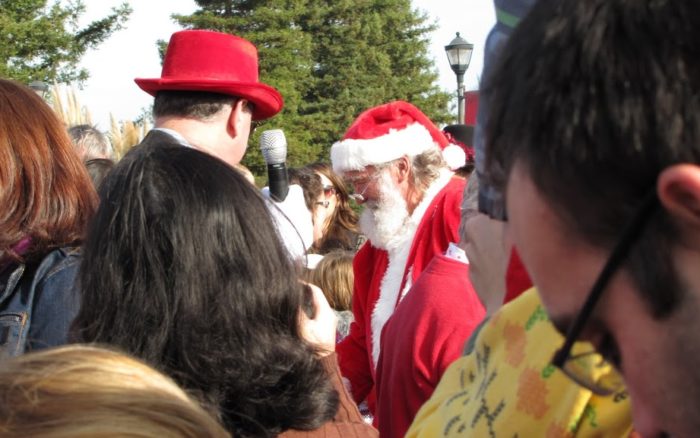Why I believe in Santa Clause
I have been thinking about Santa Claus, that jolly old Christmas saint of giving. To me he is as sparkly as Christmas lights, one of the few mysteries we participate in collectively.
As a young child I remember being taken to the “real” Santa who arrived in a parade the day after Thanksgiving and took up residence in a yearly assembled Christmas house in the center of town. We stood in long lines to see him, always a little intimidated when we finally got to sit on his lap. My mother told me that the Santas we saw on street corners and other places were not the real Santa, only his helpers, and this made sense to me.
Christmas eve we were instructed to go to sleep “so Santa Claus could come.” This was torture! I remember trying to sleep and my mother coming to the door to check on me. Once I thought I heard sleigh bells and this panicked me even more.
Eventually, though, I slept, and then my sister and I woke early. We peered into the darkened living room to check if Santa had been there yet, (Yes, he had!) and then raced to wake my parents.
We were not a wealthy family, getting “big” toys only for Christmas or, to a lesser degree, our birthdays. So to rush into the living room and see the very thing we had asked for was a most amazing experience! Those years the ultimate toy was a doll, one we perused the Sears Christmas catalogue to choose, and here she was! Our grandmother made complete wardrobes for these dolls. (She was another of Santa’s helpers, my mother explained.)
There were other gifts too: a stocking full of doll baby bottles, doll shoes, candy cane, and a red delicious apple on the top, a variety my mother never bought because it was too expensive.
I believed in Santa until I was six when one of my first grade classmates told me my parents were really Santa. When I asked my mother about this, she pulled me aside so my younger sister would not hear and told me that moms and dads are the helpers and that Santa Claus is a spirit. I don’t remember being particularly devastated, but I didn’t tell my younger sister, who believed in Santa until she was nine. Christmas was not quite the same after I found out. This transition to spirit Santa involved a kind of coming-of-age, the mantle of which I more fully accepted when we “played Santa” for our own sons.
This year Santa came to Petaluma, California, on a tug boat, which blasted down the river into the center of town. He and Mrs. Claus stood by the mast waving to the crowds as the tug, horn booming, streamed by. Suddenly I felt overcome with emotion! I felt the crowd’s excitement as Santa disembarked the tug and walked through a long receiving line to his temporary strip mall office.
The phenomenon of Santa Claus is a collective imagining of a saint of giving, most popular in United States, but with 2000 year old European ancestors in Saint Nicholas (a bishop living in 300 A.D. Patara, now Turkey), Father Christmas (England), and Kris Kringle (Germany). It is said that the first Dutch settlers coming to United States had a figure of St. Nicholas on the bow of their ships, much like in Petaluma!
Santa is vulnerable to being hijacked by commercial interests, or by intellectual reasoning. Yes, there is a let-down in the news of the lack of concreteness of his identity, but that does not negate the importance of his reality as an inhabitant of the mystery of the season. (Einstein held that imagination is more important than knowledge.) Santa inspires awe, and generosity, opening us to Spirit of timelessness and hope, but he may also serve as an initiator for children and adults alike— into a more mature version of the imaginal realm.
